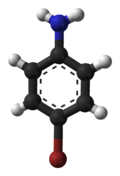| |||
| Names | |||
|---|---|---|---|
| Preferred IUPAC name 4-Bromoaniline | |||
Other names
| |||
| Identifiers | |||
| CAS Number | |||
| 3D model (JSmol) | |||
| ChEMBL | |||
| ChemSpider | |||
| ECHA InfoCard | 100.003.086 | ||
| EC Number |
| ||
| PubChem CID | |||
| RTECS number |
| ||
| UNII | |||
| UN number | 2811 | ||
| CompTox Dashboard (EPA) | |||
InChI
| |||
SMILES
| |||
| Properties | |||
| Chemical formula | C6H6BrN | ||
| Molar mass | 172.025 g·mol | ||
| Density | 1.5 g/cm | ||
| Melting point | 60 to 64 °C (140 to 147 °F; 333 to 337 K) | ||
| Solubility in water | <0.1 g/100 mL at 23 °C | ||
| Magnetic susceptibility (χ) | -84.06·10 cm/mol | ||
| Hazards | |||
| GHS labelling: | |||
| Pictograms |   
| ||
| Signal word | Danger | ||
| Hazard statements | H302, H311, H315, H319, H332, H335, H373 | ||
| Precautionary statements | P260, P261, P264, P270, P271, P280, P301+P312, P302+P352, P304+P312, P304+P340, P305+P351+P338, P312, P314, P321, P322, P330, P332+P313, P337+P313, P361, P362, P363, P403+P233, P405, P501 | ||
| Safety data sheet (SDS) | External MSDS | ||
| Except where otherwise noted, data are given for materials in their standard state (at 25 °C , 100 kPa).
| |||
4-Bromoaniline is a compound where an aniline molecule is substituted with a bromine atom on the para position. Commercially available, this compound may be used as a building block, e.g. in the preparation of monobrominated biphenyl via the Gomberg-Bachmann reaction.
Preparation
4-Bromoaniline can be made by reacting acetyl chloride-protected aniline with bromine.

Reactions
One laboratory route to 1-bromo-4-iodobenzene involves the Sandmeyer reaction. 4-Bromoaniline is treated with concentrated sulfuric acid and sodium nitrite, then potassium iodide.
References
- 4-Bromoaniline, Chemblink.com
- M. Gomberg and W. E. Bachmann (1941). "p-Bromobiphenyl". Organic Syntheses; Collected Volumes, vol. 1, p. 113.
- Banerjee, M.; Shukla, R.; Rathore, R. (15 January 2009). "Synthesis, Optical, and Electronic Properties of Soluble Poly-p-phenylene Oligomers as Models for Molecular Wires". Journal of the American Chemical Society. 131 (5): 1780–1786. doi:10.1021/ja805102d. PMID 19146375.

